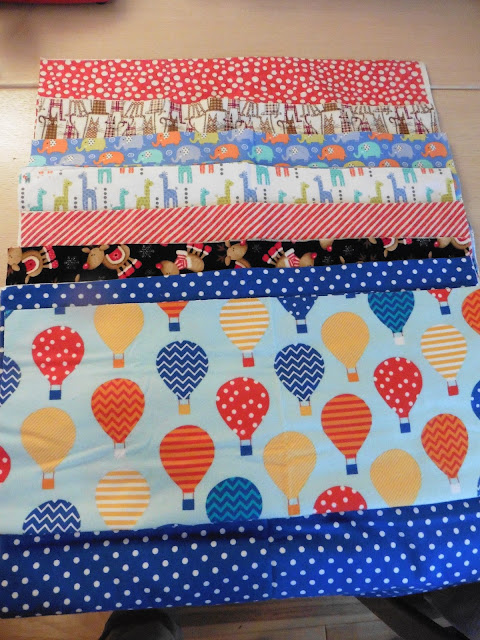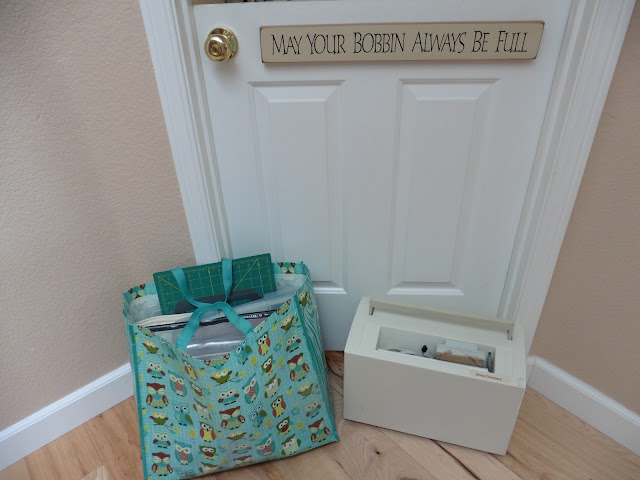What with finding a name and feathering a nest you'd think
I was the one having a baby. Well, I am, sort of. This quilt is for my grandson to be. I pieced it from the
Life in the Jungle fabric line by Doohikey Design for Riley Blake Fabrics and this week I began pondering its name and planning its FMQ execution. Here is the main focus fabric with the gray background. The list of objects on the print is quite long. I spy with my little eye:
mammals (hippos, hedgehogs, monkeys),
birds (toucans, owls, and two other feathered species),
amphibians (tree frogs),
plant life (leafy trees, lollipop shaped trees, three kinds of toadstools or mushrooms), and
shapes (stars and fireworks -like bursts). How does one come up with a name for quilt that has everything?
I let my mind wander on ideas for a name.
Oklahoma Quilt Works had assembled the kit and sold it under the title
Life in the Jungle Baby Stripper. First, I prefer not to name my quilt after the fabric line and second, this did not have a very jungle feel to it. Tree frogs? Yes. Toucans? Yes. Lollipop shaped trees and hedgehogs? Not so much.
Playing off the animal aspect, I considered but rejected the following names because they left out the trees and mushrooms, which were as prominent in the print as the animals:
Critter Capers,
Birds of a Feather,
Band of Birds (play on
Band of Brothers), or perhaps
Furred and Feathered Friends,
Fur and Feather Frolic, both of the final two being a bit of alliterative overkill.
Playing off the location aspect, I thought of tropical venues being jungle-like and considered:
Tropical Turf,
Zany Zoo,
Critterland, or even
Tiki Room. After all, everyone knows that, "in the Tiki-tiki-tiki-tiki-tiki room, all the birdies sing and the flowers croon..."
Jungle Gym was a serious contender, but again, the feature fabric was not that strongly "jungle" to me,
Concentrating on a mood avoids the issue of slighting some plants or animals in the name choice. The print has a very whimsical feel to it. The bright orange, turquoise, and lime green that are partnered with the grays and browns give off a very happy vibe and suggest a name with happy in it:
Happy Habitat,
Happy Homes,
Happy Together?
Happy Together immediately made me think of the 1967 song by
The Turtles. I am dating myself here. I suspect a fair number of bloggers and younger quilters were not even born then. Here is a
YouTube video of the song for the curious among the readers. The graphic black and white checkerboard set design and the leader singer's striped jacket is worth a peek at the video if nothing else.
But did I really want to be reminded of a defunct singing group from decades ago when I thought of this quilt? Not really. But I liked the idea of happy. Synonyms for happy are glad, joyful, cheerful, merry, fun-filled. Fun!
Fun with Friends, maybe even
Fun, Fur, Feather, and Frond for the hyperbole of alliterative overkill and a booby prize for being too long. Once the word "fun" surfaced, though, I remembered an old (and very corny) joke:
Q: Why did the Mushroom get invited to all the parties?
A: 'Cuz he's a fungi!
This quilt has found its name.
Fun Guys. With three kinds of toadstools,
Fun Guys is a cute play on words and it is easy to say. Ok, maybe some of the critters I am calling "guys" are not male, but this quilt is for a little boy so we can pretend that they are. Even the shapes of the stars and firework-like bursts fit into the name since they tend to represent parties and fun.
With an owl, a toucan and two other birds in the print, I figured this was a good quilt on which to learn to quilt feathers. Plus, now that I had the name settled, I could concentrate on learning a new skill without being distracted. I practice my quilting pattern first with a dry erase marker on sheet protectors. This allows me to doodle at the same size that will go on the quilt, erase with a scrap of batting, and try again as many times as I want. Once I am finished experimenting or practicing, since it is a sheet protector, I can then slide a white sheet of paper inside and hang the design nearby to remind me or photocopy it to keep in a binder. One caution though – I am very careful with dry erase markers around quilts. The marker pigment will not wash out of the fabric so I am sure to label the front of the sheet protector where I have drawn so I do not flip it over and have the markings rub off on the quilt top. For the mildly paranoid quilter, snapping a picture of a section of the quilt top, printing it out and sliding it into the sheet protector involves a few extra steps but can keep those markers away from the quilt during drawing. Quilt shops do sell a clear plastic by the yard that can be placed across the quilt and drawn on, instead of drawing on the sheet protectors. Plastic by the yard requires the same precautions as the sheet protectors when using dry erase markers. Here are my practiced designs, set over the quilt top. I opted for feathers on an undulating spine in the wider bands and little spheres suspended on a string in the narrower strips.

The suspended spheres on a line in the turquoise and orange strips were the first items I did and they were a bit wobbly in places. They were wobbly when I drew them, too! As to forming the feather pattern, I took the design from the book
Hooked on Feathers by Sally Terry. I was very pleased and surprised at how well I did on my first attempt. I need lots of practice on uniform stitch size and getting my tension optimally adjusted, but that is outside the scope of this book and true of whatever pattern you pick. I did the camouflaging honeycomb bands first so that by the time I got to the less-forgiving green polka dot bands, I would have improved with a little muscle memory to help me out.

Sally Terry's approach eliminates the need to backtrack along parts of the feather, a hard task to do well for a beginner. When I asked myself, "Why don't my feathers look like the sample?" she'd given concrete tips to help figure out what needed to be done differently to get the effect wanted. Notice I said effect wanted. There is no right or wrong. Tips address the angle to depart from the spine, the relative height between the inner and outer portion of the feather base, the roundness of the hook itself, etc. I highly recommend this book. It's approach is teaching me how to analyze what makes something look good, a skill artistic people seem to benefit from innately, but
can be taught. How does that saying go? "Give a man a fish and you feed him for a day; teach a man to fish and you feed him for a lifetime."
In the narrow turquoise and orange strips, I pulled a simple design from Christina Cameli's book,
Step-by-step Free-Motion Quilting. I liked that she uses color to show the sequence of creating a pattern. Here is a portion of the page showing the design I picked. It is flattened spheres staggered along a gently undulating line. Since my strip was so narrow I kept the main line fairly straight along the middle but I did not feel obligated to keep it rigidly straight. I also spaced my circles farther apart. I loosely used the black and brown honeycomb pattern to space them quasi-uniformly, chanting "black-up... brown-down... " as I alternated direction. If, when I am finished I can still find the places where I broke my "rule" I
may pick them out and reverse them. On the other hand, left in they might make a good challenge for a little boy to hunt for as a game of hide and seek.
When several lines are set side by side I think the overall effect reminds me of pussy willows. Although I only used a single line in
Fun Guys, I will keep this in mind for a future quilt.
I like that the majority of the designs in this book are fairly open. Since I prefer quilting that is not too dense, I can still get an openness without having to enlarge a pattern so big it is hard to execute smoothly. Christina Cameli's first book is project-focused, but this one has a wealth of FMQ inspiration to use on quilts or placemats or totes or whatever. This book stands very well on its own without the
First Steps book of hers. I am glad I added it to my library
These pink strips of paper are a good indicator of how many good ideas I have marked for future use. The
Look inside feature on Amazon gives a very extensive sampling of the designs inside.
Confidence in my FMQ is building slowly and I am having fun with
Fun Guys! Now, what to FMQ in the
wide-band, focus-fabric sections of
Fun Guys'?

























































